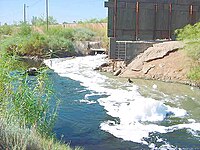
Distribution characteristics and policy-related improvements of PM2.5 and its components in six Chinese cities.
Sign Up to like & getrecommendations! Published in 2020 at "Environmental pollution"
DOI: 10.1016/j.envpol.2020.115299
Abstract: This study presents the distribution characteristics and possible sources of fine particulate matter (PM2.5) and its components, as well as policy-related pollution reduction in the Chinese cities of Jinan, Shijiazhuang (SJZ), Chengdu, Wuxi, Wuhan, and… read more here.
Keywords: pollution; distribution characteristics; policy related; chinese cities ... See more keywords

Association of PM2.5 Components with Acceleration of Aging: Moderating Role of Sex Hormones.
Sign Up to like & getrecommendations! Published in 2023 at "Environmental science & technology"
DOI: 10.1021/acs.est.2c09005
Abstract: Fine particulate matter (PM2.5) has been linked to aging risk, and a lack of knowledge about the relationships between PM2.5 components and aging risk impeded the development of healthy aging. Participants were recruited through a… read more here.
Keywords: acceleration; pm2 components; age; pm2 ... See more keywords

Association between one-year exposure to air pollution and the prevalence of pulmonary nodules in China
Sign Up to like & getrecommendations! Published in 2023 at "Journal of Breath Research"
DOI: 10.1088/1752-7163/accbe4
Abstract: PM2.5 is a well-known airborne hazard to cause various diseases. Evidence suggests that air pollution exposure contributes to the occurrence of pulmonary nodules. Pulmonary nodules detected on the computed tomography scans can be malignant or… read more here.
Keywords: prevalence; pm2 components; air; pulmonary nodules ... See more keywords

Application of Bayesian Additive Regression Trees for Estimating Daily Concentrations of PM2.5 Components
Sign Up to like & getrecommendations! Published in 2020 at "Atmosphere"
DOI: 10.3390/atmos11111233
Abstract: Bayesian additive regression tree (BART) is a recent statistical method that combines ensemble learning and nonparametric regression. BART is constructed under a probabilistic framework that also allows for model-based prediction uncertainty quantification. We evaluated the… read more here.
Keywords: bart; daily concentrations; regression; pm2 components ... See more keywords